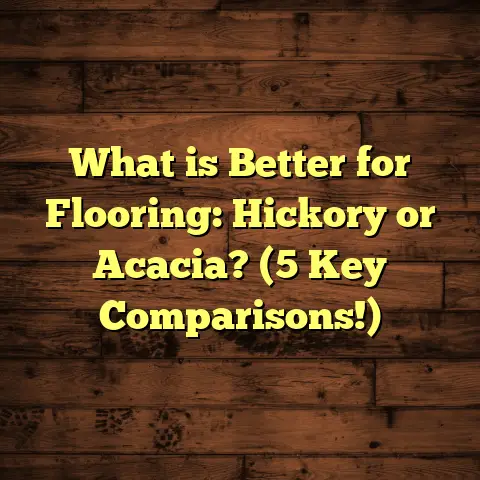What is a Clearance Floor? (5 Key Factors You Must Know!)
I used to think a clearance floor was just a cheap leftover piece of flooring
that you pick up on sale. But after years in the flooring business, I’ve learned
that the term means a lot more—especially when it comes to installation and
planning. So, what exactly is a clearance floor? And why should you care about
it if you’re planning a flooring project? Let me break it down for you.
What Is a Clearance Floor?
Simply put, a clearance floor refers to flooring materials sold at a reduced price
because they are overstock, discontinued, or slightly imperfect. But here’s the
thing—it’s not just about snagging a bargain. These floors often come with unique
opportunities and challenges that can impact your entire project.
For example, a clearance floor could be hardwood planks from last year’s batch
that didn’t sell, or vinyl tiles with minor color variations. Sometimes, they’re
damaged packaging or off-spec sizes. I’ve worked with clients who thought they
were just getting cheap materials but ended up with a high-quality floor at a
fraction of the price—others ran into trouble because the materials didn’t match
their room’s exact needs. It’s definitely more than just a clearance sticker.
The Different Types of Clearance Floors I’ve Encountered
Over the years, I’ve seen clearance floors fall into several categories:
- Overstock: These are new materials produced in large batches but not fully sold.
- Discontinued Lines: Flooring no longer made due to changing styles or supplier decisions.
- Customer Returns: Sometimes customers return unopened boxes due to change of mind.
- Slightly Damaged: Minor cosmetic defects like scratches or dents that don’t affect function.
- Off-Spec Sizes: Boards or tiles cut to non-standard sizes or with dimensional variances.
Each type has its own pros and cons. Overstock might be the easiest to work with but discontinued lines may limit your choices if you want to expand later.
How Are Clearance Floors Different From Regular Flooring?
When I started using clearance floors in my projects, I noticed several key
differences compared to standard buys.
- Material Quality: Not always lower, but sometimes the floorboards might have
small defects or color inconsistencies. - Availability: You might only get limited quantities or discontinued styles.
- Installation Challenges: Matching old stock with new stock can cause color
variation. - Pricing: Prices are generally more attractive but factoring in waste and extra
labor is important.
Over time, I learned to weigh these factors carefully before recommending a
clearance floor to anyone. It’s not one-size-fits-all, and you need to consider your
space, usage, and expectations.
Let me tell you about a few situations where I had to think twice before choosing clearance materials. In one case, a client wanted to use clearance hardwood for his living room but planned to do the adjoining hallway later. By then, the same boards weren’t available anymore. That left us with two visibly different floor styles in connected spaces.
On the flip side, for a small guest bathroom renovation, I used clearance ceramic tiles that were discontinued but looked fantastic. Since it was a confined space, color variation wasn’t an issue and the savings were significant.
My Personal Experience With Clearance Floors
A while back, I helped a homeowner looking to remodel her kitchen on a tight budget.
She found some clearance hardwood flooring online and asked if I could install it.
At first glance, the price was fantastic—almost half the cost of regular flooring.
But when the materials arrived, there were slight color variations between boxes.
That meant I had to plan the layout carefully to create a balanced look and avoid
patchiness. I ended up combining clearance flooring with some matching regular stock
to fill in gaps. The whole process took more time but saved her nearly $1,500.
On another job, I tried clearance vinyl planks for a rental property. The material was
discontinued but still very durable and stylish. The only hiccup was that I had to
order extra to cover waste since the packaging wasn’t consistent with standard sizes.
These experiences taught me that clearance floors can be great if you’re ready to adapt
and plan ahead.
What I Learned About Customer Expectations
One thing I can’t stress enough is setting realistic expectations when working with clearance floors. I remember a couple who wanted “just like new” flooring but insisted on clearance material only because of budget limits. When subtle variations showed up after installation, they were disappointed even though I had explained potential issues upfront.
Clearance floors don’t carry the same guarantees as brand-new products in most cases. So it’s vital for homeowners to understand what they’re signing up for and that some quirks may remain visible.
Comparing Clearance Floors With Other Flooring Options
Let’s compare what you get with clearance floors versus brand-new flooring or custom orders:
| Feature | Clearance Floor | Brand-New Flooring | Custom Flooring |
|---|---|---|---|
| Price | Lower | Standard | Higher |
| Availability | Limited stock | Wide selection | Made-to-order |
| Design Variety | Limited due to clearance status | Extensive | Fully customizable |
| Quality Control | Varies; may have minor defects | Strict quality checks | Highest standards |
| Installation Planning | Requires flexibility | Straightforward | Tailored approach |
In my work, some clients love clearance floors for the savings and unique look. Others prefer new floors for peace of mind and warranty coverage.
I want to share two contrasting stories that illustrate this comparison well.
Case One: Clearance Floor Success
A young couple renovating their first home wanted affordable yet stylish flooring. We found clearance laminate planks mimicking trendy wood grains at 40% off retail. Although slightly thinner than standard planks, they installed perfectly and gave their home an updated look without breaking the bank.
Case Two: Brand-New Hardwood Peace of Mind
Another client was finishing their dream home and wanted hardwood floors that would last decades. They chose solid oak hardwood from a reputable supplier with full warranty coverage. The installation was smooth; no color variation issues popped up; and their investment paid off with timeless beauty.
Both approaches worked but depended on budget, project goals, and homeowner priorities.
5 Key Factors You Must Know About Clearance Floors
1. Material Condition and Quality
Not every clearance floor is “used” or damaged. Many are perfectly fine but might have cosmetic flaws or be from discontinued lines. When I inspect clearance materials, I look for warping, cracking, or color inconsistencies.
A quick tip: Always ask for samples or photos before buying. If you can visit the supplier in person, do it. I’ve seen cases where what was advertised as “minor blemishes” turned out to be larger issues.
I recall one project where the supplier sent me clearance ceramic tiles claiming minor surface marks. When I checked them personally, several tiles had chips on edges—this would’ve caused installation delays had I not inspected first.
2. Quantity and Waste Factor
Clearance lots often come in limited quantities. One time, I started installing clearance laminate flooring only to find out halfway through that there wasn’t enough stock to complete the room. That meant scrambling for matching planks or mixing styles.
To avoid this headache, I recommend ordering at least 10%-15% extra material as a waste factor, especially if cuts and patterns are involved.
I’ve seen clients trying to cut costs by ordering just enough material end up paying double due to emergency orders or mismatched products later.
3. Compatibility With Your Space
Colors and finishes on clearance floors may not always match your existing décor perfectly. I once had a client whose clearance oak flooring looked great in the store but appeared much darker under their home lighting.
Make sure you check how samples look in your actual space before committing. Lighting and room size affect perception.
Natural light versus artificial light can drastically change how wood grains or colors appear—something I’ve learned after many installs across different homes.
4. Installation Complexity
Some clearance floors require special attention during installation due to irregular sizes or textures. This can add time and labor costs.
In one project, I installed clearance hardwood planks that had slightly different thicknesses from box to box. It took extra sanding and leveling to get a smooth surface.
Sometimes clearance tiles have slight size differences that mean grout lines don’t line up perfectly without extra adjustments.
5. Cost Savings vs. Additional Work
While clearance floors offer upfront savings—sometimes 30%-50% off retail—additional labor or material costs can offset that.
I use tools like FloorTally in my projects to keep track of all these factors. It helps me calculate total costs accurately by including local labor rates, waste percentages, and material prices in one place.
That way, when I quote clients, they get realistic budgets without surprises midway through the job.
Some Data That Might Surprise You
- According to industry reports, clearance flooring can reduce material costs by an average of 35% compared to new stock.
- However, about 20% of projects using clearance floors experience installation delays due to supply shortages or mismatched materials.
- Flooring contractors estimate that extra labor for adjusting uneven boards or color blending adds roughly 10-15% more time per project when working with clearance materials.
These numbers match my experience too—discounts are great but don’t forget the hidden costs.
A Case Study: Clearance Floors in Action
I recently worked on a community center renovation where budget constraints were tight. We opted for clearance vinyl plank flooring that had been discontinued but was highly durable and water-resistant.
By ordering extra material upfront and planning board placement carefully, we completed the installation on schedule. The client saved over $4,000 compared to buying brand-new commercial-grade vinyl.
Feedback after six months showed excellent durability with no visible wear or fading—a success story that shows clearance floors can perform well when handled properly.
Here’s what we did differently on this project:
- Ordered 20% extra material upfront considering waste and future repairs.
- Conducted thorough pre-installation inspection of all boxes.
- Planned layout with color variation in mind to create intentional patterning.
- Used professional tools and techniques to address minor size inconsistencies.
- Communicated clearly with the client about expectations and maintenance tips.
This approach prevented surprises and delivered great results despite working with clearance materials.
How FloorTally Helps Me Manage Flooring Projects (Without Sounding Like an Ad)
If you’re curious how I keep track of all these variables when working with different flooring types—including clearance floors—I use an online tool called FloorTally. It’s not just about crunching numbers; it lets me:
- Input local labor rates and material prices for accurate cost estimates.
- Factor in waste percentages based on project complexity.
- Visualize overall budget allocation so clients understand where money goes.
- Compare different flooring options quickly.
- Adjust quantities easily if stock availability changes mid-project.
Because managing costs can become complicated fast—especially when mixing clearanced items with regular stock—having one platform handle all calculations streamlines communication between me and my clients. It also helps avoid costly surprises later on.
I’m not saying it’s perfect for everyone but it’s been invaluable in keeping projects transparent and on budget.
More Examples From My Job: When Clearance Floors Worked—and When They Didn’t
Success Story: Basement Remodel
A homeowner wanted affordable waterproof flooring for their basement family room. We found clearance vinyl planks marked down 45%. The product was still under warranty despite being discontinued the previous year.
Installation went smoothly; no major defects showed up during unpacking; the floor has held up well after two years without damage or fading.
Challenge Story: Large Living Room Project
Another client chose clearance engineered hardwood flooring from multiple batches because their original choice was out of stock. Unfortunately, this caused noticeable color shifts across the floor surface after installation.
We tried blending boards during installation but couldn’t eliminate contrast completely. The client accepted it as part of the bargain price but wished they’d known about this possibility beforehand.
What You Should Ask Suppliers Before Buying Clearance Flooring
I always encourage clients and DIYers alike to ask detailed questions such as:
- Why is this product on clearance?
- How old is this stock?
- Are there any visible defects?
- What is the return policy on clearance items?
- Can you provide samples or photos of actual boxes?
- Is there enough quantity available for my entire project?
- How much extra should I order for waste?
Answers will help you avoid surprises and make sure your expectations align with reality.
Maintenance Tips for Clearance Floors
Once installed, how do you care for a clearance floor? Maintenance depends on material type but here are some general tips:
- Clean regularly using manufacturer-recommended products.
- Avoid harsh chemicals on surfaces prone to damage.
- Use furniture pads to prevent scratches.
- Address spills immediately especially on wood or laminate.
- Monitor wear areas closely since older stock might have less protective finish.
- Schedule periodic inspections if you own rental properties or commercial spaces using clearance floors.
Proper care keeps your floor looking better longer regardless of whether it was full price or discounted.
Clearing Up Misconceptions About Clearance Floors
I often hear people say clearance means “leftover junk.” Not true at all! Many times these floors are perfectly good quality products that just didn’t fit current trends or inventory needs.
Another myth is that installation will always be harder with clearance flooring. While sometimes true due to size variance or packaging issues, experienced installers can manage most challenges effectively if prepared.
Finally, some believe warranties don’t apply at all on clearance items—but this depends on manufacturer policies and retailer terms so always check carefully before purchase.
How To Decide If Clearance Flooring Is Right For You?
Ask yourself:
- What is my budget ceiling?
- Can I accept minor imperfections?
- Am I willing to spend extra time planning layout?
- Do I have access to professional installers familiar with variable materials?
- Is my timeline flexible enough for potential delays sourcing matching stock?
If yes to most questions, you could save serious money by choosing clearance flooring wisely.
If no—better stick with new stock that offers more certainty even if pricier upfront.
Final Thoughts From Someone Who’s Seen It All
Clearance floors aren’t just “cheap leftovers.” They’re real materials
with unique stories behind them—and when chosen carefully they can help
stretch budgets without sacrificing style or durability too much.
I’ve worked with hundreds of projects involving clearance materials—some
were smooth sailing; others required patience and creativity—but all taught me
valuable lessons about balancing cost versus quality versus time.
If you’re thinking about using clearance floors yourself:
- Do your homework thoroughly.
- Inspect samples personally.
- Consider ordering extra material.
- Use tools like FloorTally for budgeting help.
- Get expert advice on installation challenges.
- Set realistic expectations about appearance and delivery schedules.
And lastly—don’t hesitate to reach out if you want tips tailored specifically
to your project needs!
What’s your experience been? Have you ever used clearance flooring? Or thinking
about it now? Let’s chat!





